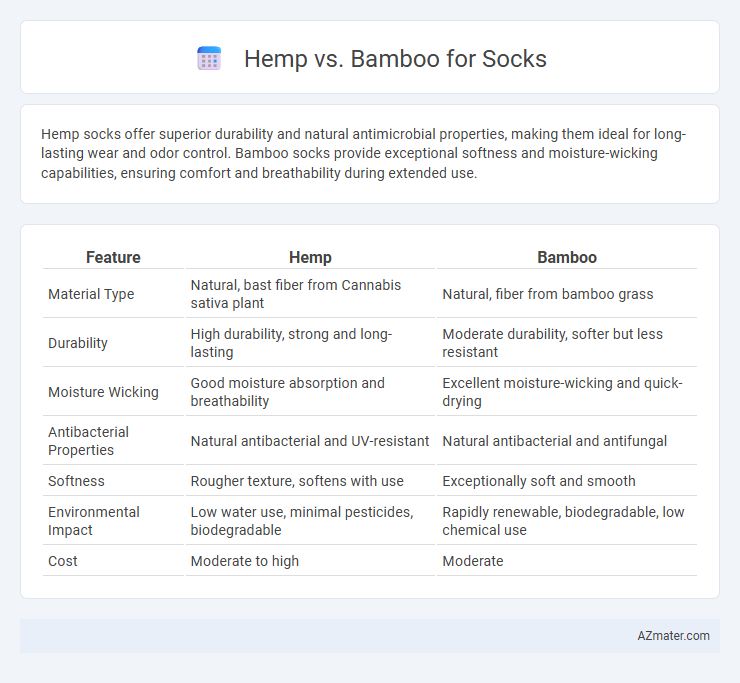Hemp socks offer superior durability and natural antimicrobial properties, making them ideal for long-lasting wear and odor control. Bamboo socks provide exceptional softness and moisture-wicking capabilities, ensuring comfort and breathability during extended use.
Table of Comparison
| Feature | Hemp | Bamboo |
|---|---|---|
| Material Type | Natural, bast fiber from Cannabis sativa plant | Natural, fiber from bamboo grass |
| Durability | High durability, strong and long-lasting | Moderate durability, softer but less resistant |
| Moisture Wicking | Good moisture absorption and breathability | Excellent moisture-wicking and quick-drying |
| Antibacterial Properties | Natural antibacterial and UV-resistant | Natural antibacterial and antifungal |
| Softness | Rougher texture, softens with use | Exceptionally soft and smooth |
| Environmental Impact | Low water use, minimal pesticides, biodegradable | Rapidly renewable, biodegradable, low chemical use |
| Cost | Moderate to high | Moderate |
Introduction to Hemp and Bamboo Socks
Hemp socks are made from fibers of the Cannabis sativa plant, known for durability, breathability, and natural antimicrobial properties that help reduce odor and moisture. Bamboo socks, crafted from bamboo pulp, offer exceptional softness, moisture-wicking, and antibacterial benefits, making them ideal for sensitive skin. Both materials provide eco-friendly alternatives to traditional cotton socks, emphasizing sustainability and comfort in everyday wear.
Environmental Impact: Hemp vs Bamboo
Hemp socks have a significantly lower environmental impact due to their minimal water and pesticide requirements, while bamboo cultivation demands considerable resources and often involves chemical processing to produce soft fibers. Hemp plants grow quickly, improving soil health through natural phytoremediation and requiring fewer inputs, whereas bamboo farming can lead to deforestation and habitat loss if not managed sustainably. Choosing hemp socks supports reduced carbon emissions and promotes sustainable agriculture compared to the often chemically intensive bamboo sock production.
Comfort and Wearability Comparison
Hemp socks offer exceptional moisture-wicking properties and durability, making them highly breathable and resistant to wear over time. Bamboo socks provide a softer, silkier texture with natural antibacterial qualities, enhancing comfort for sensitive skin. Both materials excel in breathability, but hemp's rugged durability contrasts with bamboo's superior softness, influencing wearability based on user preference and activity level.
Durability and Longevity of Hemp and Bamboo Socks
Hemp socks are renowned for their exceptional durability, owing to the plant's strong natural fibers that resist wear and tear over extended use. Bamboo socks, while soft and comfortable, tend to be less durable, as the fibers break down more quickly with frequent washing and abrasion. Choosing hemp socks ensures longer-lasting performance and better resistance to stretching and thinning compared to bamboo alternatives.
Moisture-Wicking and Breathability Features
Hemp fibers offer superior moisture-wicking properties by rapidly absorbing and releasing sweat, keeping feet dry and comfortable during extended wear. Bamboo socks excel in breathability due to their naturally porous structure, enhancing airflow and reducing odor buildup. Both materials provide excellent ventilation, but hemp's durability combined with bamboo's softness creates an optimal balance for moisture management and comfort in sock performance.
Antibacterial and Odor-Resistant Properties
Hemp fibers possess natural antibacterial properties due to the presence of compounds like cannabidiol, effectively reducing microbial growth and odor in socks. Bamboo fibers contain a bio-agent called "bamboo kun," which inhibits bacterial proliferation and helps maintain freshness over extended wear. Both hemp and bamboo offer superior odor-resistant qualities compared to traditional cotton, making them ideal for socks in active or prolonged use.
Production Processes and Sustainability
Hemp socks are produced using minimal pesticides and water, benefiting from hemp's rapid growth and natural pest resistance, which significantly reduces environmental impact. Bamboo socks require chemical processing to convert bamboo pulp into viscose, often involving toxic solvents that can harm ecosystems if not managed properly. Sustainable production favors hemp due to its lower resource requirements and eco-friendly cultivation methods, making it a more environmentally responsible choice for sock manufacturing.
Cost and Accessibility for Consumers
Hemp socks typically have a higher initial cost compared to bamboo socks due to the more labor-intensive cultivation and processing of hemp fibers, but hemp's durability offers long-term value. Bamboo socks are generally more accessible and affordable for consumers, benefiting from widespread availability and a faster production cycle. Both materials provide eco-friendly alternatives, but bamboo remains the preferred option for budget-conscious buyers seeking easy access and moderate price points.
Style and Design Options
Hemp socks offer a natural, rustic aesthetic with earthy tones and a durable texture that appeals to eco-conscious consumers seeking a rugged yet comfortable style. Bamboo socks feature a sleek, smooth finish with vibrant color retention and a variety of patterns, providing a modern and luxurious appearance. Both materials lend themselves to versatile design options, but bamboo excels in softness and sheen, while hemp emphasizes sustainability and natural appeal.
Final Verdict: Which Sock Material is Better?
Hemp socks outperform bamboo in durability and environmental impact due to hemp's natural resistance to wear and lower pesticide requirements. Bamboo offers superior softness and moisture-wicking properties, ideal for comfort and breathability. For sustainability and longevity, hemp socks are the better choice, while bamboo excels in comfort and moisture management.

Infographic: Hemp vs Bamboo for Sock
 azmater.com
azmater.com